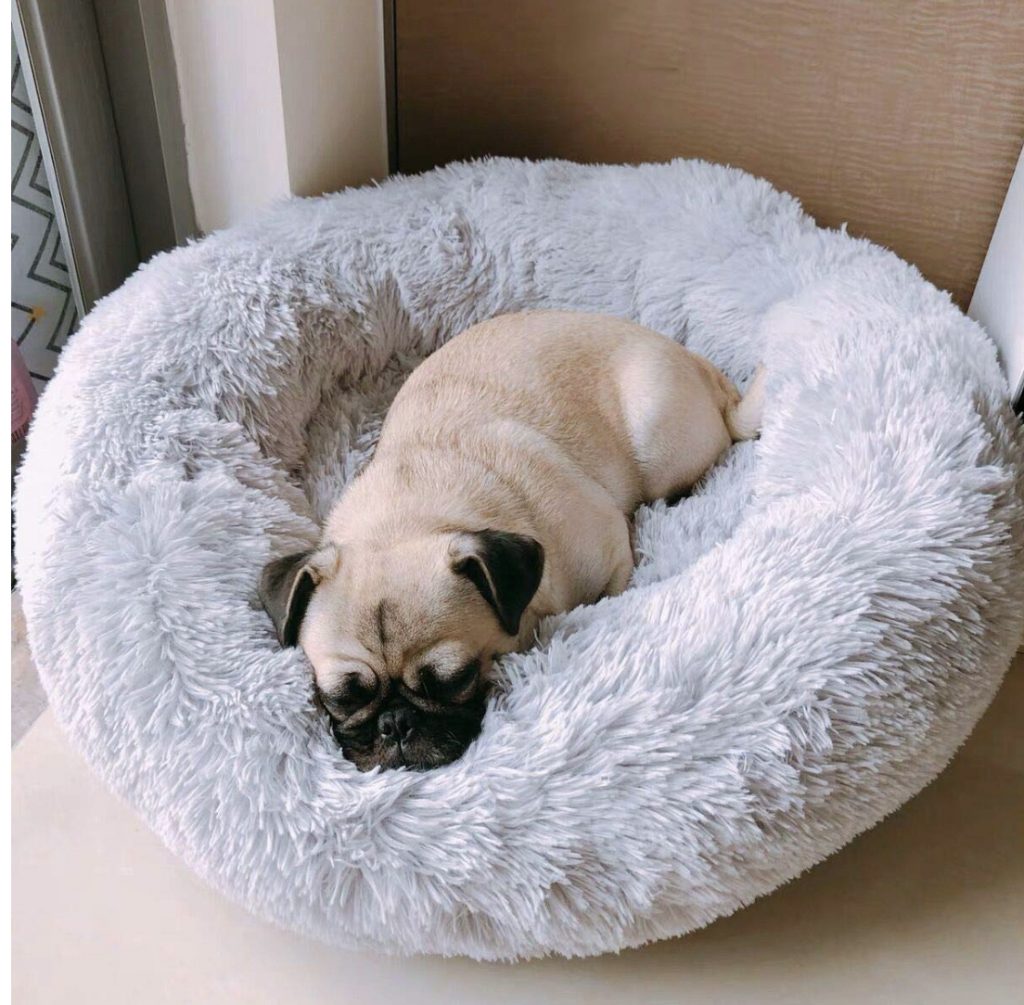Top Tips for a Happy Dog Pet Bed
Top Tips for a Happy Dog Pet Bed
A good dog bed means a happy dog.
If you’re wondering whether your dog needs a bed, then did you know the average dog stands up on his feet for only five hours per day? If you’re a dog parent, you know what they’re doing the rest of the time. Dogs spend between 12 and 14 hours per every 24 hours sleeping. Tag on another five to seven hours lying around awake but resting. Yes, your dog needs a soft, supportive place to lay down. Therefore, your dog will sleep well.
Looking for a comfortable dog bed for your dog? A comfort and a stylish look? What are the best products for your dog?. Do you want a wicker dog basket or just a soft dog bed with fleece or sturdy canvas? There are so many choices!
Dog beds can be simple or fancy, expensive or homemade, and everything in between. How do you pick the right dog bed for your pup when there are so many on the market? Does your pooch even need a dog bed? Should you spend a lot of money when your dog is just as happy lying with you in your human bed or on the couch?
These are all questions you should consider before you buy a dog bed, and this dog bed guide is here to help you make a decision. Here is everything you need to know about dog beds and the Top Tips for a Happy Dog Pet Bed.

Does Your Dog Need A Dog Bed?
The truth is, dogs need beds just like we humans do, and they are beneficial for a variety of reasons. If he/she has a bed, though, it gives him/her a place he/she can retreat to when he/she needs time by himself. Your dog needs a spot to retreat, a place to lay its head, somewhere soft and comfortable to call its own. Additionally, giving your dog a place to sleep will keep him/her from sleeping where you don’t want him/her to.
Even if your dog is allowed to sleep with you in your human bed, every dog should have a bed of their own or two.
There are plenty of benefits to having dog beds. They can be used for napping during the day and sleeping in at night. Unlike the floor, a bed will keep your dog warm, support arthritic joints and prevent calluses. Unlike a couch or human bed, dog beds are spaces that pups can have all to themselves.
And if you’re allergic to your dogs, then it’s best if he/she sleep somewhere besides your bed. Dog beds can also be taken with you when you travel so that your dog feels comfortable and is able to sleep on somewhere familiar. They will be able to rest easier and feel less anxiety. So a travel dog bed is an easier option.
Some dog beds are also usually easy to wash, which makes life easier if your dog has accidents, gets infested with fleas or mites, or just rolls in something stinky. A dog bed shouldn’t be used as a place for punishment or confinement. It’s a place of security that belongs only to that one dog, and they should always feel safe in it.
A dog bed makes a crate more comfortable, but that doesn’t mean a dog can spend twelve hours a day in a crate just because it has a bed. It’s a place dogs should be able to go and relax without feeling trapped or anxious.
All dogs could benefit from having a place where they can feel calm and de-stress during the day or night.

What Kinds Of Dog Beds Are There?
Dog beds can be as simple as your old pillow or as fancy. Your selection depends on your taste, budget and decor but you may find that your dog expresses a preference by taking over another dog’s bed. Keep an eye on where your dog feels most comfortable, as this can help you decide which bed will be best.
Basic Styles Of Dog Beds
Standard dog beds look like cushions or pillows and do not have edges or rims. They are available in many shapes, sizes, materials, and colours. Shapes typically include round, oval, rectangular, and square. Many of these beds are covered with materials such as fleece, flannel, denim, faux suede, or microfibre. They often contain a polyester filling and/or foam padding. Some beds are also filled with cedar chips to deter odours and insects. Standard dog beds range in quality from basic economy to expensive designer versions. Many have removable, washable covers.
Standard beds are great for all dog breeds, but may not offer the support needed for senior dogs or dogs with orthopaedic problems.
- Waterproof dog beds are good for outdoor use or incontinent pets.
- Doughnut-shaped dog beds are circular bolsters with a removable centre pillow.Much like nest beds, donut dog beds provide a rim or edge around the bed. This edge is a pillow-soft bolster that lets your dog really curl up and sink in. These beds are typically round or oval and made of very soft materials. Donut dog beds are extremely plush and some of the most cuddly dog beds available. Dogs love them!
- Donut beds are great for dogs that like to curl up and get cozy. However, some old or weak dogs may have trouble getting in and out of these beds.
- Flat pads or mats are inexpensive and fit in crates.
- Nesting/snuggle dog beds are similar to beanbag chairs, and often preferred by smaller dogs who love to curl up. Many dogs find these beds exceptionally comfortable.
- Covered or hooded dog beds are yet another way for dogs to snuggle up. With the appearance of small houses or tents, these beds provide a small plush retreat for dogs. Some covered beds are made entirely of plush bedding, while others consist of a standard dog bed inside a rigid house or wicker basket. A covered dog bed is a cute and unique way to give your dog a special place.
- Covered dog beds are great for all types of dogs, but small breeds tend to be especially fond of them. These beds are also wonderful for shy dogs that might like to hide.
- Cooling Dog Beds Have you ever noticed your dog lying on a cold hard floor after it’s been out playing on a warm day? Sometimes dogs really enjoy that cooling sensation. Fortunately, there are dog beds that offer a cool yet comfortable surface for your dog to relax and cool down. Cooling dog beds are typically made out of plastic or similar material and are filled with water or a gel-like liquid. For your pet’s safety, always follow the manufacturer’s instructions. Though cooling beds are great for any type of dog, breeds with a tendency to overheat will benefit the most. This especially includes bulldogs!
Special Dog Beds For Seniors Or Dogs With Medical Needs
- Orthopaedic dog beds support old joints or very large dogs; they usually have medical-grade foam and/or box-spring construction. Orthopaedic beds are designed especially for dogs with arthritis or other orthopaedic problems. Made with high-quality thick foam, these beds provide extra support for your dog’s body and put less stress on joints. Though comfortable for any type of dog, seniors and very thin dogs will especially benefit from orthopaedic beds. Like standard beds, they are available in a wide variety of colours, sizes, and shapes. Orthopaedic beds are especially good for senior dogs or those with orthopaedic problems. They are also wonderful for thin and bony dogs, such as Greyhounds and Whippets, to prevent pressure sores and calluses.
- Kennel Dog Beds Dog beds are often made especially to fit kennels and crates of many shapes and sizes. This can be much more practical than bulky blankets, but more comfortable than papers or thin disposable pads. Some companies manufacture water-resistant beds or beds that are easier to clean. If your dog spends a significant amount of time in a kennel or crate, a bed is essential. Kennel/crate beds are suitable for all types of dogs. Older or thin, bony dogs should always have beds in their kennels or crates.
- Heated beds maintain body warmth. This can be beneficial for dogs that get cold easily or for dogs with arthritis that is worsened by the cold. Want to give your dog an extra-warm place to snuggle up? Heated dog beds are a great way to do this. When combined with orthopaedic features, heated beds can be highly therapeutic for dogs with achy joints. These beds work like heating pads or electric blankets. Though designed with safety features to protect your dog, always be sure to follow the manufacturer’s instructions.
- Heated dog beds can benefit all types of dogs, but thin and/or tiny dogs may benefit the most. Outdoor dogs will do better in colder seasons if they have access to a heated bed.
- Raised Dog Beds Many companies make beds that are raised off the floor. Some are standard, nest, orthopaedic beds, or even mattresses inside a raised frame. Frames may be made of wood, wicker, metal, or plastic. Other raised beds are designed to look like dog-sized sofas, even down to the smallest detail. Imagine it—you could match your dog’s furniture with your own! One benefit of a raised bed is that it keeps a bit of distance between a cold, dirty floor and your dog. Plus, insects have a bit farther to go before they invade your dog’s bed. Raised dog beds may not be appropriate for dogs with orthopaedic problems or breeds prone to back problems, such as dachshunds. Jumping to and from the bed could cause harm or discomfort.
- Travel dog beds are portable, so your dog can have the security of the same bed every night while on the road. For dogs who suffer from anxiety in new places, this can help them relax and get some sleep. If you enjoy traveling with your dog, then you may want to consider keeping a travel bed on hand. These beds are much like standard dog beds, except that they fold or roll-up. This saves space while you head to your destination.Travel beds are wonderful for any dog that likes to travel!
- Cot-style dog beds keep your dog off the ground and comfortably support joints by distributing the dog’s weight evenly. They are also usually fairly easy to transport.
What Is The Best Dog Bed For Your Dog?
There are so many dog beds on the market. How do you pick the best one? There are many factors to take into consideration, including size, cost, comfort, your dog’s medical needs, convenience and so much more.
You should do your research and consult your vet about your pup’s needs before you make a decision. Here are several factors to consider when choosing the best dog bed:
- Easy washability Dogs eat treats, vomit, pass gas, scratch fleas, and wipe ointment-filled eyes and ears on their beds. Some dogs urinate on them–so the ability to throw the bed into the washing machine is a big help, if not downright critical. Dogs with allergies will also benefit from having their bed washed frequently.
- Safety Place the bed away from high-traffic areas so no one trips on it or on the dog. If the dog chews it, then get rid of it–swallowing stuffing can lead to emergency surgery. Remove any buttons or ribbons the dog could chew, or look for the “chew-proof” beds now available.
- A good fit Beyond finding something within your budget, make sure your dog fits on the bed; heads and limbs shouldn’t have to be hanging off the edge. Buying a bed that’s too large for your dog can leave him or her feeling insecure, so look for a bed that’s just large enough for your dog to stretch out. Smaller dogs are also much more likely to get chilly, so it’s important to find a bed that keeps drafts to a minimum.
- Stuffing that works for you and your dog Young, warm, healthy dogs can usually get by with inexpensive foam filling, but your older or arthritic dog will probably prefer more comfort and support. While some orthopaedic beds use foam, it’s thicker and of higher quality, so it doesn’t squash flat. Snuggle beds and some outdoor beds have Styrofoam beads. Thick, flexible gel has recently become more common as a bed filling; it’s more comfortable than foam and distributes weight more evenly, making it excellent for geriatric dogs–but expensive. And some beds contain cedar chips to keep them smelling fresher than your dog.
- The environment Some of us are concerned about using materials that won’t harm the earth when we decide to replace, get rid of, or recycle a dog bed. You can check out eco-friendly dog beds if that is something that factors into your decision.
- Absorbent pads for dogs who wet the bed Sick, incontinent, or geriatric dogs can benefit from washable or disposable absorbent pads.
